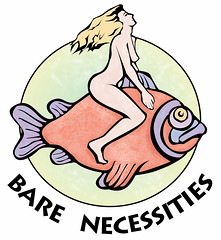 For years nudists have been were content to remain behind fences aware that these barriers serve a dual purpose. They protect the non-nudist public from having to view nakedness but they also kept voyeurs and people who were unsympathetic to nudity from harassing them. Today the nudist community is “coming out of the closet” and beginning to speak out for nudism in an attempt to acquaint non-nudists with the importance of body-acceptance and the joy of nude recreation. With these “outreach” efforts, beginning along the Eastern seaboard American naturism began to spread west.
For years nudists have been were content to remain behind fences aware that these barriers serve a dual purpose. They protect the non-nudist public from having to view nakedness but they also kept voyeurs and people who were unsympathetic to nudity from harassing them. Today the nudist community is “coming out of the closet” and beginning to speak out for nudism in an attempt to acquaint non-nudists with the importance of body-acceptance and the joy of nude recreation. With these “outreach” efforts, beginning along the Eastern seaboard American naturism began to spread west.Nudism continues to grow in popularity and acceptance as it has become to be seen as more mainstream. Actively and effectively promoting the ideals that human bodies are good and worthy of acceptance, and that nakedness is not synonymous with sex, there has begun a change in the perspective of mainstream Americans. More and more non-nudists are adopting a more tolerant view of nudists even if they are not themselves interested in participating, as the understanding develops that there is no wholesale debauchery, sex orgies or perversion going on inside the fences of nudist clubs and resorts. Normal people are simply enjoying a game of tennis, a hike, swim, sunbathe sharing a meal in the nude with the same friendliness as other normal people do the same activities while clothed. As the nudist movement goes beyond its early “underground” character and becomes more mainstream and as attitudes and legislation unfriendly to the practice of open nudity become more accepting, nude recreation continues to expand beyond the privacy of fences to include activities such as the expansion of nude beaches and nude cruises.
Change is always a slow process, and to date the establishment of nude beaches has been far more successful in Europe than in America, given the more relaxed attitude that Europeans have towards nudity. Still there are many reasons to feel positive about the fact that public social trends seem finally to be catching up with social nudism. For example, in 1972, the California Supreme Court ruled that “nudity” was not in itself illegal or criminal unless accompanied by acts of lewdness. This ruling opened a crack in the dike of anti-nudity laws and has served as a model for changes in anti-nudity laws in other states. Today there is no ban on nudity while on federal land, although at the discretion of local park superintendents rangers may issue citations under local state and county laws if they so choose.
Nudity outside the confines of the established clubs and resorts still remains far from common even with changes in official policy and laws. But there has been progress. Organized nude river rafting on the Colorado River is now common at the Grand Canyon and nude house boating no longer turns any heads at Lake Mead and Lake Powell. Bed and Breakfast inns and motels catering exclusively to nudist vacationers have sprung up from Palm Springs to Palm Beach. By the end of the 1990’s, Forbes Magazine estimated that the nudist tourist industry was generating over $800 million in business annually. “Hippie Hollow” on Lake Travis near Austin, Texas, has a long tradition of nude recreation with no legal trouble. Despite frequent court victories by nudist supporters there are still enough people in America who consider nudity offensive that the nudist movement still has a long ways to go before gaining the acceptance or at least tolerance of the majority of mainstream America. Yet things are slowly looking better. It is much easier today than ever before for nudists to enjoy backcountry travel, cruises and other travel and recreational opportunities with the advent of travel agencies that specialize in clothing optional recreation. A growing tolerance in society for nudity and awareness of the naturalness and wholesomeness of nudism continues to move forward. Those who practice social nudism/naturism look forward to the day when their chosen lifestyle no longer has to be confined to tall privacy fences or remote beaches.







No comments:
Post a Comment